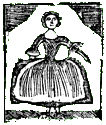White said he didn’t know—not mentioning that earlier in the evening he’d clubbed a teen-aged barber’s apprentice, Edward Garrick, on the head.
Then Crothers saw people coming from the direction of the Town House (now the Old State House). She heard them say, “There’s the Centinel, the bloody back Rascall, let’s go kill him!” Those people had been riled up by Garrick and his friends, hoping for justice.
Crothers would later testify in court about what happened next. There are two sets of notes about what she said, mostly in agreement. An anonymous notetaker recorded:
They kept gathering throwing Snow balls, Oyster Shells and chunks of Wood at the Centinel. Beat him from out of his Box to the steps.This testimony, from one of the very few women on the scene that night, helped to exonerate Capt. Preston of having ordered the soldiers to fire.
A space after saw a party coming from the Main Guard, an Officer which proved to be Capt. [Thomas] Preston with them. He desired his Men to halt and the Centinel to recover his Arm, fall into his Rank and march up to the Main Guard. The Centinel fell in and the men wanted to move forward to the Guard house but could not for the Riot.
The people called out fire, damn you why dont you fire, you cant kill us [all]. I steppd to the Party. Heard a Gentleman ask the Capt. if he was going to order his men to fire. He said no Sir by no means, by no means. A Man—the Centinel—then pushed me back. I step’d back to the corner. He bid me go away for I should be killed.
A Man came behind the Soldiers walkd backwards and forwards, encouraging them to fire. The Captain stood on the left about three yards. The man touched one of the Soldiers upon the back and said fire, by God I’ll stand by you. He was dressed in dark coloured Cloaths. I don’t remember he had a Surtout or any lace about him. He did not look like an Officer. The man fired directly on the word and clap on the Shoulder.
By the time of Preston’s trial, Jane Crothers was no longer Jane Crothers. On 27 March, three weeks and a day after the Massacre, she married Pvt. Joseph Whitehouse of the 14th Regiment at Christ Church (Old North). She was thus attached to the army, though not identified as such in the trial records.
Instead, those notes record another unusual aspect of Jane Whitehouse’s testimony. Under Massachusetts law, witnesses could swear to tell the truth simply by holding up their hand and reciting or assenting to an oath. But someone “said that Jane Whitehouse thought there was no obligation from Oaths administred by holding up the hand.” She was therefore “Sworn upon the Bible.” I’ve tried to find a discussion of that distinction from the period in hopes that it would say something about the woman’s religion, and I haven’t.
TOMORROW: What Pvt. Whitehouse had to say.

Great story and first-hand account.
ReplyDeleteHi JL, I'm a longtime fan of your blog.
ReplyDeleteI'm especially interested in this post as rather coincidentally I have an article being published on this Sunday the 5th on www.emergingrevolutionarywar.org entitled "Speaking Softly: Female Voices of the Boston Massacre". (To celebrate both the anniversary of the massacre as well as Women's History Month.)
In it, I talk about Jane Whitehouse and Elizabeth Avery's eyewitness accounts of the massacre and how they seem to be the only two women who testified as to their firsthand observations of the shootings amidst a sea of male witnesses.
In my research, I had only come across Whitehouse's name as Whitehouse, not Crothers. I have been unable to find hide nor hair of Whitehouse after the massacre and perhaps it was because I've been searching under Whitehouse only.
(As an aside, I did find that an Elizabeth Avery married a Gilbert Watson on April 1, 1775.)
I'll ping you with my article on EmergingRevWar when it comes out, if you happen to be interested in taking a look at how I put together Avery and Whitehouse's stories. (I'm a history enthusiast, not a scholar.)
I always learn something new by visiting your blog and I appreciate your meticulous research!
Thanks, Katie! I'll look forward to your blog post on Sunday.
ReplyDeleteAlong with Elizabeth Avery, Ann Green also testified about what she saw at the Massacre. But the bare record of her testimony simply confirmed what Avery had just said.
Thanks for the pointer about Avery's marriage intention (in 1771, right?).
Boston marriage records show Jane Crothers marrying Joseph Whitehouse in March 1770. After that, she would appear in records only as Jane Whitehouse. She might show up in other places that she traveled with her husband and the 14th Regiment.